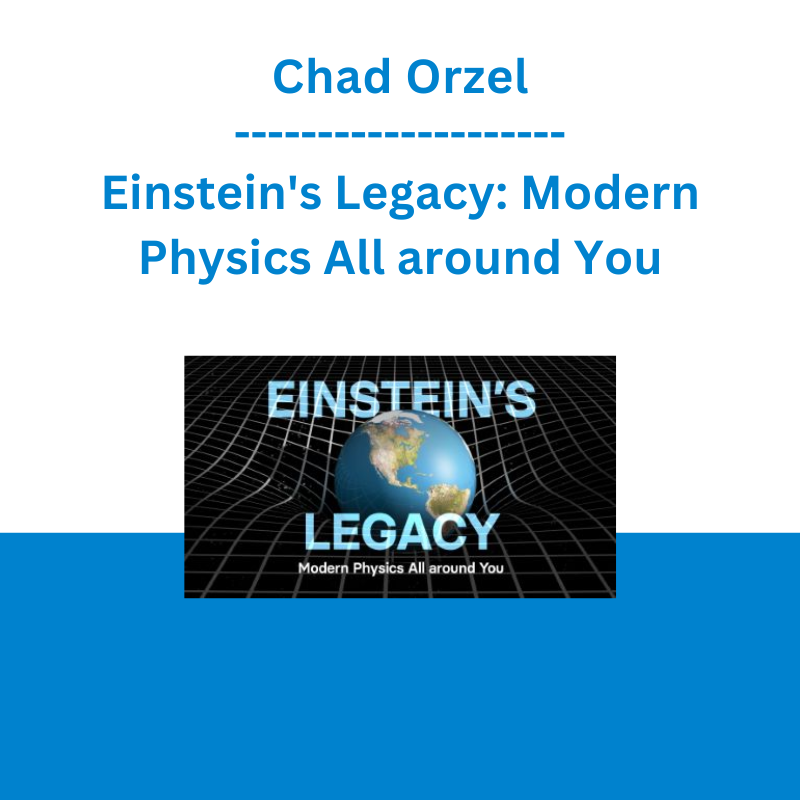*** Proof of Product ***
Exploring the Essential Features of “Chad Orzel – Einstein’s Legacy: Modern Physics All around You”
Einstein’s Legacy: Modern Physics All around You
Reveal the extraordinary physics in ordinary life.
LECTURE
Trailer
01:Toasters, Planck, and Modern Physics
Any time you see a heating element glow as you toast a slice of bread, you are looking at the phenomenon that gave birth to quantum physics. Begin your study of the relevance of modern physics to everyday life by probing Max Planck’s formulation of the quantum hypothesis at the turn of the 20th century. Planck’s ideas explain why your toaster doesn’t kill you with high-energy radiation!
26 min
02:Cameras and Einstein’s Photoelectric Effect
Albert Einstein won the Nobel Prize in Physics, not for his theory of relativity, but for his explanation of the photoelectric effect. Learn how his startling proposal that light is composed of a stream of particles (later called photons) overthrew the view that light is exclusively a wave. Discover that photons and the photoelectric effect are behind the operation of digital cameras.
24 min
03:Modern Clocks and the Bohr Atom
In 1913, Niels Bohr proposed a model of the atom that allowed physicists to predict atomic properties that had previously been completely mysterious. As a bonus, Bohr’s model provides the conceptual foundation for timekeeping using atomic clocks, where the “ticking” is the oscillation of light. Study the workings of these super-accurate devices that are good to a second in a hundred million years.
24 min
04:GPS and Einstein’s Relativity
Delve into the principle of relativity, first proposed by Galileo Galilei and later extended by Einstein to account for inconsistencies in the interpretation of electromagnetic phenomena. See how Einstein’s special theory of relativity was the result, with astonishing consequences for our understanding of time and space. The Global Positioning System (GPS) would be hopelessly inaccurate without it.
22 min
05:Elevators Demonstrate General Relativity
Continue deeper into relativity by exploring Einstein’s general theory of relativity, which treats gravity as indistinguishable from a simple accelerating reference frame—for example, an elevator that is speeding up or slowing down. From this insight, Einstein developed a theory with truly staggering implications, such as that space and time alter in the presence of massive objects.
23 min
06:Lasers, the Internet, and Photon Emission
The internet relies on Einstein’s theory of stimulated emission of radiation, along with the later work of physicists who turned the idea into a practical invention, namely the laser. Follow a single photon in a laser as it multiplies, forming a tight, concentrated beam. Then study the role of fiber optic cables in guiding laser digital signals throughout our global telecommunications network.
24 min
07:A Sense of Smell Relies on Pauli Exclusion
Starting with the aroma of freshly brewed coffee, zero in on the nose’s chemical receptors that mediate smell. Consider the quantum effects involved—notably Wolfgang Pauli’s theory of electron spin and his exclusion principle, which together dictate how electrons fill energy states within the atom. The grouping of electrons in the outermost shell determines essentially all of chemistry.
24 min
08:Why Everyday Objects Don’t Implode
Given the overwhelming amount of empty space in atoms, what accounts for the stability of solid objects? Shouldn’t they implode at the slightest touch? Chart the search by Erwin Schrödinger, Werner Heisenberg, and others for an explanation. Discover that the physics that lets you set down a cup safely also governs the most exotic matter in the universe—the material making up a neutron star.
24 min
09:Computers and Schrödinger’s Cat
Learn the link between Schrödinger’s famous cat paradox and the microelectronics revolution. In the paradox, a cat is simultaneously both dead and alive due to the indeterminate nature of an atomic process on which the feline’s fate depends. See how the physics of superposition—as this state is known—is essential to the behavior of everyday objects and plays a crucial role in computer circuits.
25 min
10:Magnets Need the Quantum World
Einstein was understandably entranced by magnets since the behavior of permanent magnets is so hard to explain. Dive into the quantum world to discover why most atoms are non-magnetic, yet some—like iron—are prone to holding a long-lasting magnetic charge. Find that the Pauli exclusion principle once again is a key element. Also probe the surprising sophistication of refrigerator magnets.
23 min
11:Smoke Detectors and Quantum Tunneling
A popular type of smoke detector relies on a tiny amount of radioactive material that undergoes alpha decay, allowing the identification of minute smoke particles in the air. Delve into the marvel of quantum tunneling which physicist George Gamow used to explain the otherwise baffling process of alpha decay. Also learn that Heisenberg’s famous uncertainty principle is a related concept.
26 min
12:The Future of Cryptography Is Entanglement
Quantum physics provides a way to make codes that are completely uncrackable, thanks to a strange property first identified in one of Einstein’s failed attempts to overthrow the theory. Close the course by investigating the most bizarre quantum phenomenon of all: entanglement. Einstein called it “spooky action-at-a-distance,” yet it may one day safeguard your most private data from eavesdroppers.
28 min
DETAILS
Overview
Taught by Professor Chad Orzel of Union College, this course takes an unusual approach to teaching quantum mechanics and relativity. Designed for non-scientists, the 12 lectures focus on how quantum theory and relativity explain the workings of everyday objects—from toaster to computer chips to smoke alarms, and much more. Using no math, the explanations are detailed and often delightful.
About
Chad Orzel
Quantum physics affects everything that we do. I hope knowing this inspires you to look at the world anew and find a bit of wonder in the most mundane activities.
Chad Orzel is an Associate Professor of Physics and Astronomy at Union College in Schenectady, NY. He earned a BS in Physics from Williams College and a PhD in Chemical Physics from the University of Maryland, College Park. In addition to teaching and conducting research, he is the author of several books explaining physics to nonscientists. His first book, How to Teach Quantum Physics to Your Dog, has been translated into more than a dozen languages. Subsequent books include How to Teach Relativity to Your Dog; Eureka: Discovering Your Inner Scientist; Breakfast with Einstein: The Exotic Physics of Everyday Objects; and A Brief History of Timekeeping: The Science of Marking Time, from Stonehenge to Atomic Clocks. He also maintains a blog about science (among other topics) at ChadOrzel.com, contributes to Forbes online, and writes on Substack. In 2021, he was named a fellow of the American Physical Society.
REVIEWS
leadsled
San Antonio, Texas
Great survey of physics and modern technology
This is a short survey of physics and its application to modern technology, such as cell phones, digital cameras, atomic clocks, GPS, lasers, magnets, smoke detectors, and cryptography. Not only does Professor Orzel explain how these gadgets work, but he also introduces some of the physicists who helped develope them, such as Einstein, de Broglie, Pauli, Schrodinger, Heisenberg, Bohr, Bell, and Rutherford. Very interesting and well worth the money.
Please see the full list of alternative group-buy courses available here: https://lunacourse.com/shop/









